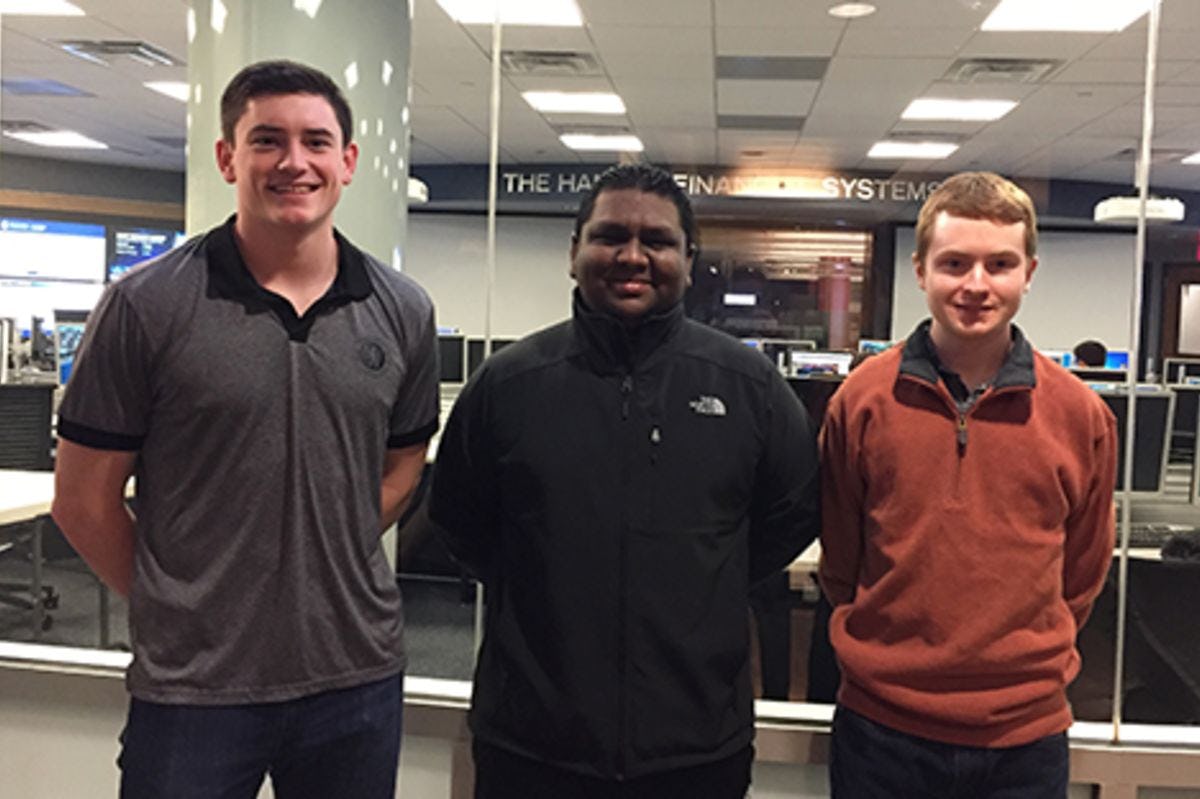Stevens Fed Challenge Team Earns Honorable Mention in National Competition
Unique Blend of Quantitative, Business and Presentation Skills Places Students among Nation's Best
Unlike other schools participating in the College National Fed Challenge, Stevens Institute of Technology doesn’t offer a course designed to prepare teams for the rigorous competition.
Maybe that’s because, unlike other schools, Stevens students from the School of Business bring quantitative lessons from the classroom and practical experience from internships to the table. Or perhaps it’s the experience of running the university’s successful Student Managed Investment Fund, or an emphasis on collaboration and presentation skills in every class.
Whatever the formula, it paid off for a team of three Stevens seniors, who earned an honorable mention at this year’s Fed Challenge, a first for the School of Business.
“We complement each other very well,” said Tom Flannery, a Quantitative Finance student who will be pursuing a master’s in Finance upon earning his bachelor’s degree in May. “We each have our own specialties, based on our internships and experience, and we collaborate well. So instead of just splitting up the work, we were able to share ideas, agree on how to approach our work, and rely on each other during the presentation.”
Behind the scenes at the Fed
The Fed Challenge introduces students to the work of the Federal Open Market Committee, including the operation of the Fed and the implementation of monetary policy. For students interested in careers in finance or economics, it’s an invaluable behind-the-scenes look at the roles of the regulators who guide the workings of the U.S. economy.
Each team of three to five students gives a 20-minute presentation to a panel of Fed economists, who then question the students extensively about their data, methodology, conclusions and so on.
Most teams of students are backed up by a small army of alternates, all of whom take special classes and get credit hours for competing, said the team’s advisor, Dr. Stefano Bonini. Lacking such a class, the Stevens students prepared for the challenge alongside their internship responsibilities and class schedules.
“At Stevens, you have hungrier people than in other schools,” Dr. Bonini said. “Elsewhere, if students don’t land the job or the internship, it’s not the end of the world. That’s not the case at Stevens — students here will do whatever it takes to get that job.”
That’s one reason the School of Business is so successful at placing students, with 100 percent of graduates of the Class of 2016 employed or enrolled in graduate school within six months of commencement.
Applying skills in a real setting
The experience of managing the SMIF was of particular help in the challenge, said Ronak Shah, a team member who also is majoring in Quantitative Finance.
“When we ran the fund together, we did a lot of presentations for the Stevens advisory board, and the Stevens investment committee, and a lot of very distinct people,” said Shah, who will be working full time at Mizuho upon graduation, following a successful internship there. “We do a lot of presentations as part of our classes, but our work with the fund helped us identify what needs to be highlighted, how you move through a presentation. It’s one thing to present to your classmates, another thing to present to a donor who’s name is on the lab you’re working in.”
Tim Leahey, the third member of the team, is a Finance major who has accepted a position in the capital markets group at Scotiabank. He said the team’s work with SMIF helped him bring varying perspectives and issues together in preparing for the Fed Challenge.
But it was still a bit intimidating at first, he said.
“You’re in this small room with these people who know it all — they publish the rates that control the world economy,” Leahey said. “We don’t know everything that they know, so it’s intimidating in that sense — but once you get into a groove and prove you’re comfortable with the details, it gets easier.”
The team’s presentation assessed everything from employment and government spending to housing trends and commodities pricing. The Stevens students fell back on lessons from classes, internships — even the pages of the Wall Street Journal, required daily reading in Dr. George Calhoun’s classes.
“I’ve had to read The Wall Street Journal every day for four years now, to the point where I read it on my own — not to get an A on his quiz, but for the knowledge that’s in it,” Leahey said.
The team members said lessons — and practice — with professors Bonini, Calhoun and Richard Anderson made up for not having a dedicated class for the Fed Challenge. For Shah, a key lesson in working with Stevens faculty and in presenting to the Fed was the ability to confidently voice and support his arguments when talking to an expert audience.
“Our professors shared a lot of their insights with us as they worked with us in mock presentations,” Shah said. “And obviously, in the challenge, you’re talking Fed policy with the guys who wrote it. So being able to validate why we made a decision, for instance, without faltering or stumbling, is something I’ll carry over in my career.”




